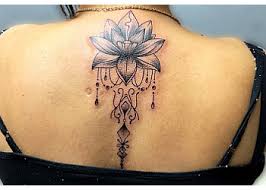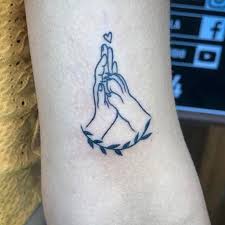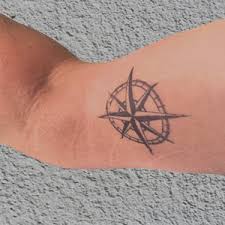TATTOO

Ötzi the iceman had a total of 61 tattoos, which may have been a form of acupuncture used to relieve pain.
Radiological examination of Ötzi’s bones showed “age-conditioned or strain-induced degeneration”
corresponding to many tattooed areas, including osteochondrosis and slight spondylosis in the lumbar spine and
wear-and-tear degeneration in the knee and especially in the ankle joints. If so, this is at least 2,000 years before
acupuncture’s previously known earliest use in
Process
Tattooing involves the placement of pigment into the skin’s dermis, the layer of dermal tissue underlying the
epidermis. After initial injection, pigment is dispersed throughout a homogenized damaged layer down through
the epidermis and upper dermis, in both of which the presence of foreign material activates the immune system’s
phagocytes to engulf the pigment particles. As healing proceeds, the damaged epidermis flakes away
(eliminating surface pigment) while deeper in the skin granulation tissue forms, which is later converted to
connective tissue by collagen growth. This mends the upper dermis, where pigment remains trapped within
successive generations of macrophages, ultimately concentrating in a layer just below the dermis/epidermis
boundary. Its presence there is stable, but in the long term (decades) the
pigment tends to migrate deeper into the dermis, accounting for the
degraded detail of old tattoos.

Equipment
Some tribal cultures traditionally created tattoos by cutting designs into the
skin and rubbing the resulting wound with ink, ashes or other agents; some
cultures continue this practice, which may be an adjunct to scarification.
Some cultures create tattooed marks by hand-tapping the ink into the skin
using sharpened sticks or animal bones (made into needles) with clay formed
disks or, in modern times, actual needles.
The most common method of tattooing in modern times is the electric tattoo
machine, which inserts ink into the skin via a single needle or a group of
needles that are soldered onto a bar, which is attached to an oscillating unit.
The unit rapidly and repeatedly drives the needles in and out of the skin, usually 80 to 150 times a second. The
needles are single-use needles that come packaged individually.
In modern tattooing, an artist may use a thermal stencil paper or hectograph to first place the design print on the
skin before working with the machine and needle on skin. This process has enabled artists to create very detailed
artworks on the skin.


Practice regulation and health risk certification Tattooing is regulated in many
countries because of the associated health risks to client and practitioner, specifically local infections and virus
transmission. Disposable plastic aprons and eye protection can be worn depending on the risk of blood or other
secretions splashing into the eyes or clothing of the tattooist. Hand hygiene, assessment of risks and appropriate
disposal of all sharp objects and materials contaminated with blood are crucial areas. The tattoo artist must wash
his or her hands and must also wash the area that will be tattooed. Gloves must be worn at all times and the
wound must be wiped frequently with a wet disposable towel of some kind. All equipment must be sterilized in a
certified autoclave before and after every use. It is good practice to provide clients with a printed consent form
that outlines risks and complications as well as instructions for after care.
Are Tattoos Safe?
As long as you go to a reputable artist that is following all recommended safety precautions, getting a tattoo is
perfectly safe. Make sure you’re fully honest about any medical conditions.
Does It Hurt?
Pain is really relative. Everyone has a different tolerance for pain. We’re not going to kid you, though—it does
hurt. Just not that much. Some have compared it to a “hot scratching feeling.” But, people would not be returning
again and again for tattoo after tattoo if it hurt that bad. Most of us are not into pain, but the beauty of the tattoo
and the pride associated with wearing it far outweighs a little pin-stick here and there.
What about using some kind of numbing cream? These kinds of products are really not recommended.
How Much Is It Going to Cost?
When it comes to tattoos, you get what you pay for. Yes, there are plenty of people tattooing out there that will
charge very little. But, look for quality, and be willing to pay for it. Never haggle over the price of a tattoo. It is
disrespectful to the artist. Think of it this way: This is a piece of art you’ll wear for life.
Should I Tip My Tattoo Artist?
Tipping is a really nice gesture. But, there are no real solid ground rules for tipping, so follow these suggestions.
What Should I Get? And Where?
This is all a matter of personal taste. You can get whatever you want, and whatever your artist is willing to do.
You can choose a picture off the wall, or you can have them create a custom piece just for you. Your only limit is
your own imagination. As far as where you should get it goes, just keep in mind what you do for work and the
type of social circles you are in. You might want to consider placing your tattoo where it can be easily covered up
with normal clothing.

What Is the Best Time of Year to Get a Tattoo?
Although you can get a tattoo any time of the year, your skin gets a lot more abuse during the summer with
swimming, tanning, and just being exposed to the elements more. Winter time is really the best season to get a
tattoo.
Is It OK to Get a Tattoo if I’m Sick?
Getting a tattoo when your immune system isn’t at 100% isn’t a good idea. You’re going to need your strength
and your white blood cells to heal your tattoo, something your body won’t be able to do if it’s already battling
against viruses and bacteria. Not to mention the fact that it’s very inconsiderate to bring your illness into the tattoo
studio and risk passing the germs onto others, particularly your artist. If you have an appointment, call and
reschedule for when you’re feeling well again.
Where Can I Find Pictures of Tattoos?
If you’re getting a tattoo, especially as an expression of your individuality, why would you want a tattoo just like
someone else’s? Instead, find other pictures of what you’re looking for and have your artist draw up a custom
design for you. Example: If you are wanting a tattoo of a penguin standing on a glacier, find real photos of
penguins and glaciers. If you want a tattoo of a blue rose wrapped around a cross, find pictures of real roses and
crosses that you like. If the pictures don’t show exactly what you want, just take them to your artist to use them as
guidelines and tell them what changes you want to make to the original pictures. A real artist will welcome the
challenge of a custom piece.
Is Tanning OK When You Have Tattoos?
It might be really tempting to get some rays during the summer months or hit up the tanning salon, but before you
ruin your tattoo, please read about tattoos and tanning.
I Just Got a New Tattoo on My Leg – Can I Shave?
It will take some time for your skin to heal enough for you to shave again and it can vary from person to person.
My Friend Just Bought a Tattoo Kit and Wants to Practice on Me
Do not let them do it. Your friend could be putting both of your lives in danger by foolishly trying to learn this at
home. Tell them they need to get a proper apprenticeship, and they can start practicing on you when their mentor
(master) feels they are ready.




